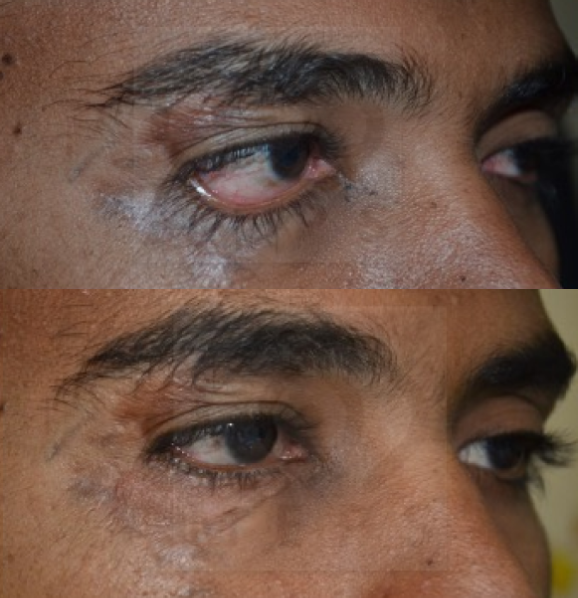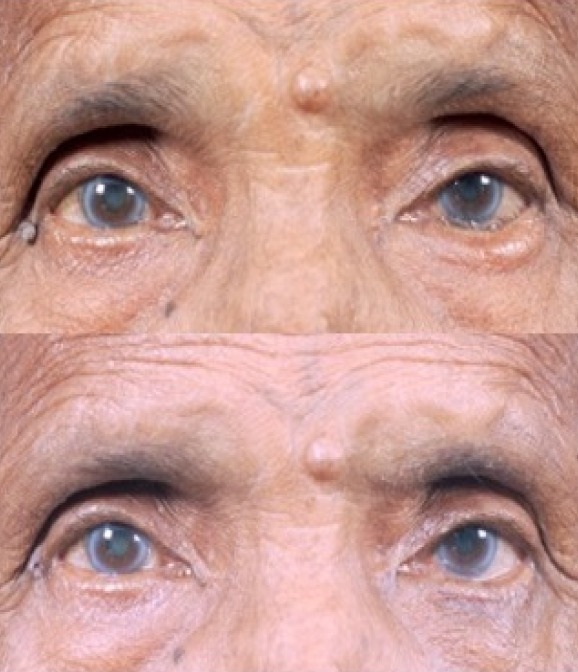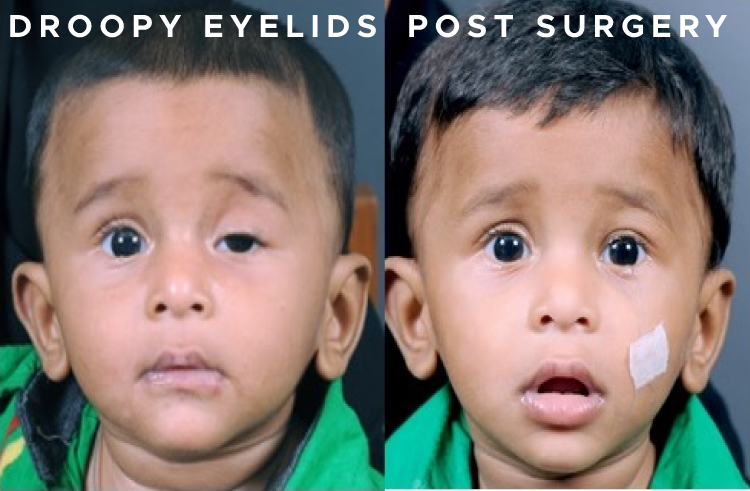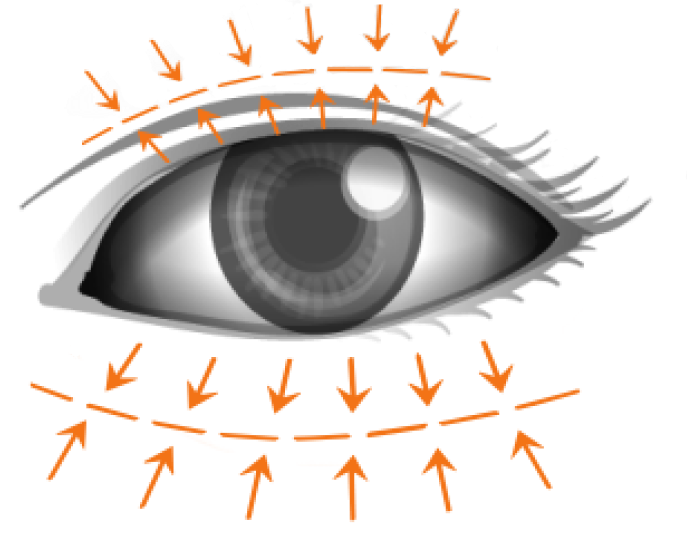Ophthalmic Plastic Surgery, DacRyology, Ocular Oncology & Aesthetic Services include
EYELID SURGERY
An eyelid surgery may be needed for functional conditions or performed for aesthetic reasons.

Out-turned Eyelid (Ectropion)
Ectropion is an everted eyelid mainly caused due to eyelid laxity. It is commonly seen in old age due to attenuation of the eyelid muscles. Outturning of the eyelids can lead to watering and redness of the eyes. Apart from aging changes ectropion can also be seen in cases of chemical injury of eyelids, burns and tumors.
Treatments:
We follow a stepwise approach to rehabilitation of these patients.First step is to
preserve the ocular surface by using artificial tears and reversing the causative
factor. Sometime skin cream preparations maybe used to reverse dermatitis.
Second and more definitive step is an ectropion surgery which is usually performed
under local anesthesia and may or may not involve the use of skin grafts.

In-turned Eyelid (Entropion)
Entropion is in turning of the eyelid. It may affect the upper or the lower eyelid. If it is not treated, the condition can lead to pain, tearing, discharge, and irritation associated with decreased vision. The eyelashes may rub the eye surface along with the skin. An in turned eyelid can result in acute sensitivity to light and may lead to eye infections, corneal abrasions, or corneal ulcers.
Treatments:
Entropion requires surgical treatment. There are a number of surgical techniques for
successful treatments. For the lower eyelid tightening of the lower eyelid muscle is
required along with reattachment of the retractors. For the upper eyelid
rearrangement of the eyelid tissue may be needed along with membrane or skin grafts.
All these surgeries are performed under local anesthesia.

Droopy Eyelids (Ptosis)
Ptosis of the eyelid signifies reduction of the eyelid aperture size. It may occur at birth in children or in adults as an aging change. With adults, it may occur as a result of aging, injury, or muscular or neurologic disease. Rarely, ptosis may be due to certain neurological/ myogenic problem. Surgery is the most common treatment modality for patients seeking correction of droopy eyes. Children with ptosis may also have amblyopia (“lazy eye”), squint astigmatism, or blurred vision. In children, surgery becomes necessary at an early age to prevent lazy eyes. In adults it may be a functional or cosmetic surgery depending on the amount of ptosis.
Treatments: The treatment of ptosis is mostly surgical and there are different surgeries for ptosis. Your doctor will explain the pros and cons of each surgery and choose the best suitable for your case. Surgery may be done by tightening the eyelid muscle (levator resection); by connecting the eyelid muscle to the forehead muscle (frontalis suspension) or via a cosmetic approach (mullerectomy).
Eyelid Reconstruction Surgery
Eyelid reconstruction surgery is a plastic surgery performed to recreate the eyelid to retain proper blink reflex and eye function. It is usually performed after the eyelid tissue is removed for eyelid cancers or following eyelid trauma. These are complex surgeries which are usually performed under general anesthesia and need about two weeks recovery time.
COSMETIC EYELID SURGERY
-
Upper Eyelid Blepharoplasty: aims at removing excess skin and rarely fat from upper eyelid
-
Lower Eyelid Blepharoplasty (Eyelid bag surgery): Here fat is removed via a hidden incision behind the eyelid. Sometimes, in addition skin may have to be removed
-
Canthoplasty: Here the corner of the eye is lifted to prevent sagging of the eyelids
-
External/ Direct brow lift
-
Endoscopic brow lift
-
Chemical brow lift
Blepharoplasty
Blepharoplasty is usually cosmetic procedure to enhance the appearance of the periocular area. It usually aims at reversing the aging changes that happen around the eyes. Blepharoplasty is a customized surgery where planning varies from patient to patient. It is very important to discuss expectations before the surgery with your surgeon. These surgeries are performed by designing the incisions in the natural folds of the eyelid for cosmetic outcomes
Treatments:
Brow lift
Drooping of the eyebrows is called as eyebrow ptosis. It is due to aging in majority of cases but is also seen in patients of face paralysis. Depending on the extent of brow ptosis a suitable procedure may be chosen.
Different procedures offered:
Botulinum and Facial Fillers
-
Eyelid spasms
-
Hemifacial spasm
-
Watery eyes
-
Cosmetic face injections for crow’s feet, eyebrow shaping, smile lines, forehead lines
-
Dark circles/ Under eye hollows
-
Eyebrow lift
-
Contouring of face
-
Medical conditions like improper eye closure, epiblepharon, scars
Botulinum toxin injection is common for cosmetic procedures but is also used for functional problems. We offer botulinum injections for the following indications:
Fillers are hyaluronic acid gels injections used to enhance the cosmetic appearance of the face. They are commonly used for:
LACRIMAL SYSTEM (WATERING EYES)
-
Punctoplasty
-
Canaliculoplasty
-
Probing under endoscopic guidance
-
Conjunctival- DCR
-
Lacrimal gland Botox
Blocked Tear Ducts
The most common symptoms include mucous at the inside corner of
the eye and/or along the lashes, excessive watering and in advanced cases infection and
pus around the eyes.
some children are born with blocked ducts from birth and may need treatment for the
same.
Treatments:
In children, lacrimal compresses or probing is performed at the
appropriate age to overcome this block.
In adults, the only definitive treatment is a surgery where the blocked sac is bypassed.
This surgery is called a dacryocystorhinostomy. It can be done via the external (skin)
or the endonasal (nose) route using a telescope.
Your surgeon will create a new drainage opening from the blocked sac directly into your
nose to bypass the obstruction in your nasolacrimal duct. A DCR is an outpatient
procedure that may be done under sedation or general anesthesia. You may have a bit of
nose bleeding for a few days after the procedure. Most people recover in less than a
week.
Other services offered:
THYROID EYE DISEASE
-
Correction of eyeball protrusion- Orbital decompression surgery
-
Correction of double vision and squint
-
Correction of eyelid issues- Eyelid retraction surgery
-
Cosmetic correction- Blepharoplasty
Thyroid eye disease is commonly seen in patients with hyperthyroidism but may also present in patients with hypothyroidism or normal thyroid levels. It is usually an autoimmune disease and presents with bulging eyes, staring appearance, pain behind eyes, double vision, eye infection and sometimes vision loss. Treatment is complicated and requires high precision surgeries with specialized equipment and team work.
Treatments:
Treatment is divided in two parts:
Conservative:
This involves supportive care in the form of lubricant drops, goggles and ice compresses. Here we also work with an endocrinologist to control the hormone levels. Sometimes, in severe cases steroid injections may be needed.
Surgical:
ORBITAL SURGERY
-
Orbital tumors (Orbitotomy)
-
Orbital fractures with implants
-
Orbital decompression
-
Optic nerve decompression
Orbit is the bony cavity within which the eyeball is located along with other crucial structures. Tumors, fractures, infections can commonly affect these structures necessitating specialized care.
Treatments:
Orbitotomy is a highly specialized surgery needing dedicated personnel and equipment including a high-speed drill and endoscopy system. Most of the orbital surgeries are performed under general anesthesia and may require overnight stay at our hospital.
SOCKET SURGERY
-
Enucleation with implant
-
Evisceration with implant
-
Dermis Fat Graft
-
Fornix formation
-
Mucous Membrane Grafts
-
Customized artificial eye- Ocularistry
Cosmetic Artificial Eye (Enucleation & Evisceration)
Loss of eye due to trauma or disease is a life changing event. We offer rehabilitation of these patients by replacing the volume with proper implants and providing cosmetic rehabilitation by fixing a customized artificial prosthesis. These treatments are usually carried out in two stages over a period of 1-2 months.
Treatments:
Contact Us
A Unit of Shantilal Shanghvi Foundation
Copyright © JGDHealth. All Rights Reserved.


